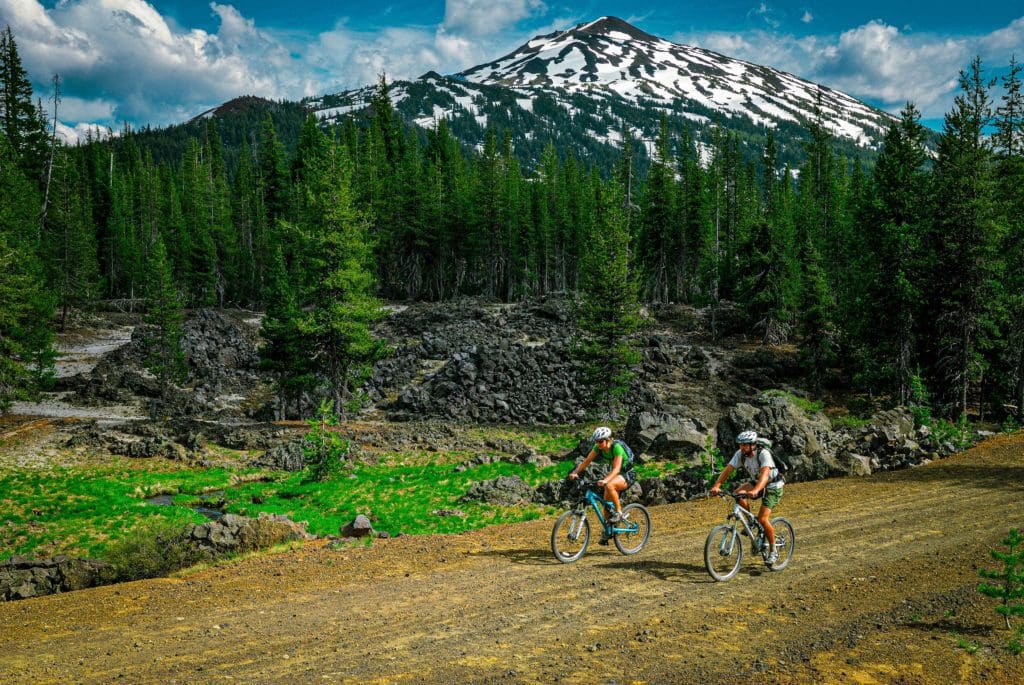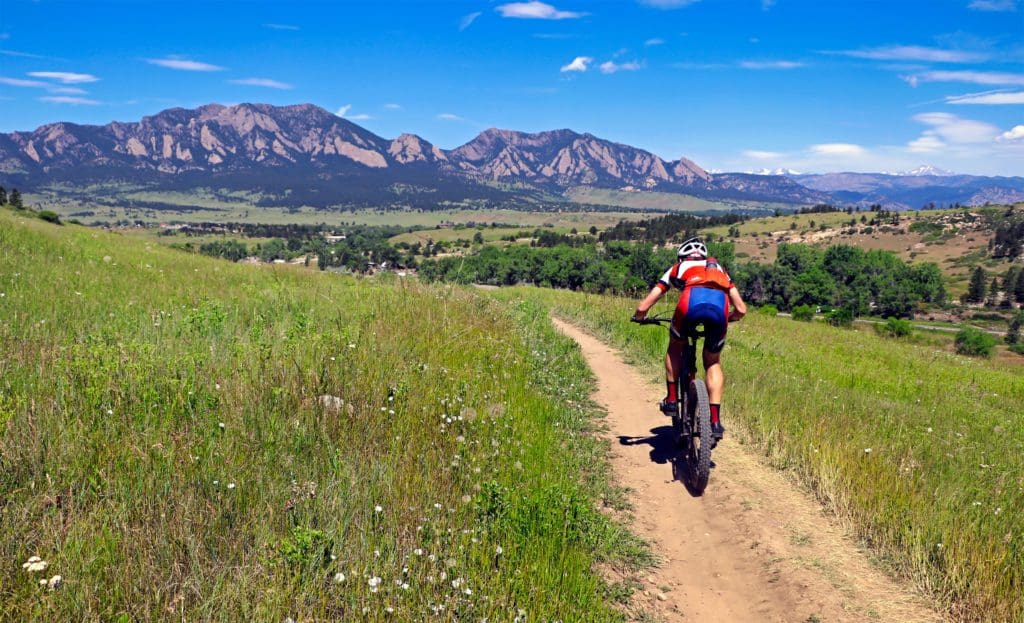|
Getting your Trinity Audio player ready...
|
Mountain biking can be intimidating with gear, techniques and trails to consider. Here’s our Skyblue Guide to help you get started for maximum outdoor fun.
With countless possibilities for exhilarating experiences and stunning landscapes all over the world, mountain biking offers an incredible way to connect with nature. However, for beginners, figuring out how to enter this thrilling sport can seem overwhelming. Along with the numerous opportunities that await, there is also a vast array of gear, techniques, and trails to navigate. It may seem daunting at first, but having a basic understanding of mountain biking before you hit the trails will ensure maximum enjoyment. After all, the ultimate goal is to have fun and explore the great outdoors.
Here is our Skyblue Guide to getting started in mountain biking:
Table of Contents
Article Navigation: Click on any of the listed items in the table of contents below to jump to that section of the article. Similarly, clicking on any large, white section header will jump you back to the Table of Contents.
- Choosing a Bike
- Accessories & Other Necessities
- Where to Ride Your New Mountain Bike
- Take a Class & Learn Basic Technique
- Volunteer & Give Back
Choosing a Mountain Bike
Buying a mountain bike is a big commitment. It’s not unusual to roll up to a trailhead and see a $6,000 bike sitting on top of a $2,000 car. Unless you’re really good at imaginary braapping, you’re going to need a bike. There are a couple main points to think about when looking for your first mountain bike.

Mountain bikers riding along a dirt road under Mount Bachelor Oregon
What kind of riding will you be doing?
Sure, we all love watching videos of the pros hucking big air and ripping technical trails, but it’s important to be realistic about the type of riding you’ll actually be doing. Get an idea for what types of trails are available in your area, and what style of riding appeals to you. There are specific mountain bikes for specific types of riding, as well as bikes that can do a little bit of everything. You’ll get the chance to try out different styles when you demo bikes. Getting an idea of what trails you’ll be riding most often — be it smooth flow trails, dirt forest roads, or technical downhill trails — will help you choose a proper pony (aka mountain bike).
Think long-term:
Do you see yourself progressing and wanting to upgrade in a year? In 3? Should you skip the in-between-more-affordable-bike step and spend abit more now to avoid spending more later? Are you keen to eventually make trips to Whistler’s bike park? A hardtail 29er won’t be great for charging down A-Line… Want to go on multi-day bikepacking adventures? A 6-inch travel bike without a lockout isn’t going to be ideal for long days in the saddle… Thinking ahead can save you a lot of time, money, and hassle and help you get a bike that’ll best suit your needs both now and in the future.
Mountain Bike Styles & Features
After some introspection, it’s time to start looking at bikes. Things can get confusing, with many different specs like wheel size, suspension, and different styles of riding, but don’t fear. The next step is actually putting some tires to dirt, and demoing different mountain bikes. A couple things to think about when doing background research to help you pick your next mountain bike are the style of bike and features.
There are several styles of mountain bikes, built to handle different kinds of terrain. Thinking about the kind of trails you’ll be riding is a great way to narrow down the different styles of bikes. Check out our full guide on mountain bike styles.
Once you have a general idea of what style of mountain bike you want to try, it’s time to do some research on the different parts that make up the bike. There is a lot that goes into making a mountain bike ride the way it does, with each component playing a part. While some mountain bikers obsess over each and every component on their bike, there are a couple main areas to focus on.

Mountain biker on the Dirty Bismark trail near Boulder, Colorado
Wheel Size:
Although geometry plays a huge role in how a bike handles, the general rule of thumb is that bigger wheels roll better over obstacles, while smaller wheels are more maneuverable.
Frame Size & Geometry:
Most mountain bikes offer on an extremely low standover height, so the traditional method of standing over the bike flat-footed doesn’t really work. Consequently, mountain bike manufacturers use Small, Medium, Large sizing and give their own size recommendations based roughly on your height.
Suspension:
Bumpier trails with hefty drops and big jumps typically warrant more suspension (i.e. longer travel). On the other hand, high mileage singletrack and tighter, technical terrain that involves a fair amount of pedaling tends to benefit from less suspension (i.e. shorter travel).
Guide: Mountain Bike Wheel Size
Guide: Mountain Bike Geometry & Frame Size
Guide: Mountain Bike Suspension
Rental Mountain Bikes
After ogling the latest and greatest on the glowing screen, it’s time to get out and try some bikes. Renting is really the best way to find out what bike is right for you. Testing before you ride can help you decide on things like wheel size, frame size, and flat out what feels best (although the least technical, ‘feel’ should trump all else). Make sure the rental bike is set up properly, from suspension sag to the position of the brakes on the handlebars. If you have pedals already, bring those for the rental. Ride it like you own it, don’t be scared because it’s not yours. Make sure you take notes after your ride, too, that’ll help you remember the subtle differences between mountain bikes. At evo, the price of up to three rentals will be applied to the price of a bike.
evo Seattle Mountain Bike Rentals
evo Portland Mountain Bike Rentals
evo Denver Mountain Bike Rentals
evo Salt Lake Mountain Bike Rentals
evo Snoqualmie Pass Mountain Bike Rentals
evo Hood River Mountain Bike Rentals
evo Whistler Mountain Bike Rentals
Buy Your New Bike!
Once you’ve weighed all of these various factors from style, to geometry, to on-trail performance, it’s time to take the plunge and buy the bike. Get stoked, because new bike day is the best day!
Rental and demo bikes are available at evo Seattle, evo Portland, evo Denver, evo Whistler, evo Salt Lake, evo Snoqualmie Pass, and evo Hood River. (Note: The cost of up to three evo bike demos can be applied toward the final cost of purchasing a new or used bike from evo.)
Accessories & Other Necessities:
Now that you’ve got that shiny new bike, you’ll need just a couple more accessories to get you out and on the trail. For mountain biking, it’s very important to have not only a helmet and pads, but also a basic repair kit to fix problems, like flat tires, that might arise on the trail.
All mountain bikers should use a helmet and carry a repair kit at a minimum. A pair of padded bike liner shorts will go a long way towards making your ride more comfortable, especially if you’re not used to spending hours in the saddle. Depending on your riding style, pads are highly encouraged.
A basic repair kit should include:
- A spare tube
- Tire levers
- Patch Kit
- Multi Tool
- Pump or CO2 Inflator
- Zip Ties
Shop Bike Helmets
Shop Bike Accessories
Shop Bike Clothing
Where to Ride Your New Mountain Bike?
Once you have your mountain bike kit dialed, it’s finally time to get out and explore the trails. Finding new places to ride is one of the most rewarding parts of mountain biking, but can also be stressful or confusing. Thankfully, there are some great resources online that can help you find the trails in your area that best fit your riding. Check out evo’s mountain bike trail guides. The Trailforks app (available for Android and iOS) can also be a great tool to find trails in your area, with maps, difficulty ratings, reviews, and more.
Washington: Discover the best mountain biking trails in Washington state
Oregon: Discover the best mountain biking trails in Oregon
Colorado: Discover the best mountain biking trails in Colorado
Moab: Discover the best mountain biking trails in Moab
Park City: Discover the best mountain biking trails in Park City
Whistler: Discover the best mountain biking trails in Whistler
Squamish, BC: Discover the best mountain bike trails in Squamish, BC
Lake Tahoe: Discover the best mountain bike trails near Lake Tahoe
Take a Class & Learn Basic Techniques
Climbing / Uphill
Descending/Downhill
Here in our backyard, we love taking classes with Evergreen Mountain Bike Alliance. From foundations classes that start with body position, shifting, and braking basics to freeride classes that progress into cornering, jumping, and dropping techniques, there’s a welcoming environment for every rider to learn and join the local mountain bike community. For mountain bikers not in Washington, there are similar clubs and groups all over the USA and the world.
Volunteer & Give Back
Where do all of the awesome mountain bike trails come from? They certainly don’t appear from thin air. Most mountain bike trail systems are built in partnership with public lands and local mountain biking groups. The construction of new trails relies heavily on time and money volunteered by the local community. Putting in some time digging is a great way to give back to the local riding community, and also to meet more riding partners.
Directory of Trail Associations & Groups
Skyblue Featured Video: What to Wear Mountain Biking
About evo
evo explores the collaboration between culture and sport by seamlessly joining art, music, streetwear, skateboarding, snowboarding, skiing, mountain biking and wakeboarding. Evo’s aim is to bring all things relevant to the urban, action sports lifestyle into one creative space. Whether it is on the website, on the phone or in their stores, evo’s aim is to make all who come into contact with evo feel welcome and excited about their experience.
Evo’s website launched in 2001, after lots of coffee, countless late nights, 100’s of powder days, and early morning sessions on the lake, they are still focused on being a great retailer and asset to the community. evo’s retail locations in Seattle, Portland, and Denver are more than just stores – evo is passionate about creating community anchors in urban settings with diverse groups of people who share common interests. Music events, movie premiers, art exhibitions, benefits to help children in need, partnerships and simply providing a great place in a central location are all ways that they work to build and strengthen community. It is no mistake that evo’s locations are venues, art galleries, and retail spaces all wrapped into one.
Learn more here:
Video: Mountain Bike Upgrades & Modifications
Video: Mountain Bike Sizing, Fit, and Geometry
Popular Articles:
Adventure Talk: Discover the Hidden Trails of Iceland
How to Choose a Longboard & Longboard Deck Shapes








